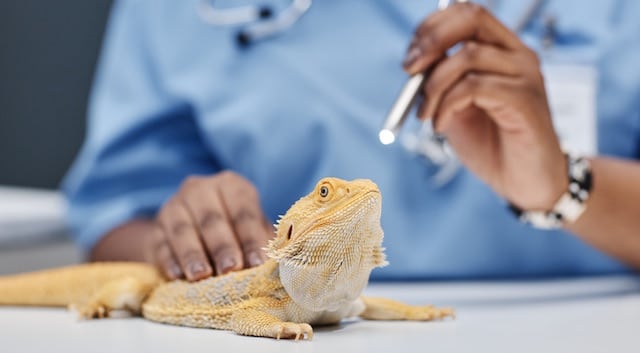
Introduction to Bearded Dragon Eye Infections
Eye infections are one of the most frequent health problems seen in bearded dragons and can negatively impact their overall health and well-being. Their eyes play a major role in their behavior and how they hunt and communicate.
An eye infection can cause serious discomfort and impair their vision, making it difficult for them to function normally. That’s why it’s essential to care for a bearded dragon’s eyes properly and treat signs of infections immediately.
Anatomy of Bearded Dragon Eyes
Bearded dragons have fascinating eyes with similar functions and purposes to humans. Their eyes are positioned on either side of their head, giving them a wide vision field to detect movement and potential predators. They have binocular vision, which helps them navigate their environment and hunt small prey. Like humans, bearded dragon’s eyes are composed of a cornea, iris, lens, and retina.
The cornea is the transparent covering over the iris that protects their eyes from dust and debris. The iris is the colorful part of the eye, and behind it is the lens, which focuses light onto the retina. The retina converts this light into electrical signals that get processed in their brains.
These reptiles also have a transparent third eye known as the “parietal eye” located between their lateral eyes. This third eye is similar to their lateral eyes, with a lens, cornea, and retina. However, it connects from the parietal gland to the pineal gland in their brains rather than the optic nerve like their lateral eyes. The third eye’s purpose is to help with thermoregulation, hormone production, balance, navigation, and regulate circadian rhythms.
Unlike humans, bearded dragons have three sets of eyelids. The outer set is called the nictitating membrane, which is a clear membrane that moves across the eye from the corner. The top and bottom eyelids close while they sleep or bask and protect their eyes from sun damage.
Common Causes of Bearded Dragon Eye Infections
Here’s an overview of the four common causes of eye infection in bearded dragons:
Bacterial and Fungal Infections
Most eye infections in bearded dragons are caused by bacteria or fungi that can flourish due to poor husbandry practices. Incorrect temperature and humidity levels, a lack of UV lighting, and unhygienic environments can lead to a buildup of harmful bacteria. These conditions can stress your bearded dragon, which lowers their immune system and makes it difficult for them to fight off infection.
Bacterial and fungal eye infections can cause swelling, discharge, and discoloration in one or both eyes. In severe cases where the eyes are swollen and crusted, bearded dragons can struggle to open their eyes entirely.
Hypovitaminosis A
Vitamin A deficiencies are very common in bearded dragons and can lead to a condition called hypovitaminosis A. This condition can make them more susceptible to eye infections by blocking their tear ducts. According to experts at the Veterinary Vision Center, vitamin A is crucial for normal skin cell development and turnover. Severe cases can put these reptiles at risk of organ failure, so it’s important to take them to an exotic veterinarian for treatment.
Signs of this condition include:
- Squinting
- Corneal inflammation
- Swollen eyelids
- Mucus or debris in eyes
- Dry eyes
Parasitic Infections
Certain parasites like cestodes, mites, and nematodes can irritate a bearded dragon’s eyes and cause infections. Bearded dragons can contract parasites through unhygienic environments, poor diets, or exposure to other reptiles. Red, swollen eyes are usually the first sign that parasites might be attacking your bearded dragon eyes. This can worsen over time and eventually lead to discharge and eye crusting that can seal their eyes shut.
Foreign Bodies and Trauma
Bearded dragon’s eyes can become infected from injuries caused by trauma from foreign bodies, like substrate or debris. Sharp rocks or platforms in the enclosure can also injure their eyes. This makes the injured eye prone to infection because harmful pathogens can enter the wound.
Symptoms of Eye Infections in Bearded Dragons
Bearded dragons show both physical and behavioral symptoms of eye infections. Their symptoms will vary depending on the cause and severity of the infection.
- Swollen eyes: The eyes appear puffy and swollen, usually around the eyelids. This can affect either one or both eyes.
- Redness: The infection causes redness around the eyes due to irritation and inflammation.
- Discharge: Thick, yellow discharge may leak from the eyes.
- Crusted eyes: A buildup of discharge can make the eyes appear dry and crusty.
- Discoloration: The eyes may look dull or cloudy.
- Closed eyes: Difficulty opening eyes from inflammation or crustiness.
Diagnosing Eye Infections in Bearded Dragons
Eye infections in bearded dragons are diagnosed by exotic veterinarians through a physical examination and diagnostic tests. The veterinarian will examine your bearded dragon’s eyes and look for common signs of infection. They might question you about your bearded dragon’s history, behavior, and environmental conditions to determine a possible cause for their symptoms.
Depending on their findings, the veterinarian might run a few diagnostic tests like a swab culture, x-ray, or blood test. X-rays are usually only necessary if the vet suspects the eye infection could be from injuries. Blood tests are helpful for detecting underlying health issues that can contribute to your bearded dragon’s eye infection, like a vitamin A deficiency.
Treatment Options
Treatment will depend on the type of eye infection your bearded dragon has and its symptoms. The veterinarian will prescribe the necessary treatment after the initial diagnosis. You will have to treat your bearded dragon’s eye infection as directed by the veterinarian to ensure they have a successful recovery.
Generally, topical medications like antibiotic eye drops and ointments are used to treat bacterial and fungal eye infections. Lukewarm water and medicated drops can be used to soothe the infected eyes and remove any discharge or crust.
Eye infections caused by hypovitaminosis A are treated with vitamin A supplementation. The vet will give your bearded dragon a vitamin A injection and suggest dietary changes to correct the deficiency.
Home Care and Nursing
You can help your bearded dragon recover from their eye infection by keeping them comfortable and their environment clean. It’s also important to monitor their behavior and infected eyes for any improvement or worsening. Most veterinarians will schedule a follow-up appointment to check their progress and whether the treatment is working properly.
Proper hygiene helps to prevent the eyes from being re-infected by harmful pathogens in a dirty environment. You should regularly remove uneaten food and soiled substrate and sanitize any platforms and surfaces. It’s a good idea to remove sharp or loose substrate to prevent further eye irritation.
Preventing Eye Infections in Bearded Dragons
Proper husbandry practices can help to prevent eye infections in bearded dragons. Their enclosure should be kept clean so that harmful pathogens don’t build up. You can spot-clean it daily by removing uneaten food and washing their food and water bowls.
The enclosure should be deep cleaned a few times a month, which involves replacing soiled substrate and wiping the glass, platforms, and decorations. Any sharp or rough items, such as rocks or sticks, should be removed from the enclosure to prevent eye injuries.
Furthermore, feeding a healthy, species-appropriate diet can prevent eye infections caused by a vitamin A deficiency. Bearded dragons are omnivores and should eat both insects and plant-based foods for essential vitamins and minerals. Foods like dandelion leaves, collard greens, and mustard greens are excellent sources of vitamin A and should be included in their diet.
When to Seek Veterinary Care
Most eye infections don’t resolve on their own and must be treated by an exotic veterinarian. You shouldn’t attempt to treat your bearded dragon’s eye infection with home remedies or medications without guidance from a veterinarian. Their eyes are delicate and can easily be damaged with the wrong treatment methods.
You should book a veterinary appointment for your bearded dragon if you notice any changes in their eyes, whether it’s redness, swelling, or squinting. Early detection is important for prompt treatment to give your bearded dragon the best chance of a successful recovery.
Conclusion
Eye infections are one of the most common eye problems in bearded dragons that can take a toll on their health. It’s essential to take them to the vet for prompt treatment if they show signs of an eye infection. An eye infection can impair their vision and make it difficult for them to do basic functions like hunt, communicate, and navigate their environment. You can prevent your bearded dragon from developing an eye infection with proper care and feeding a healthy diet to prevent vitamin A deficiency.



